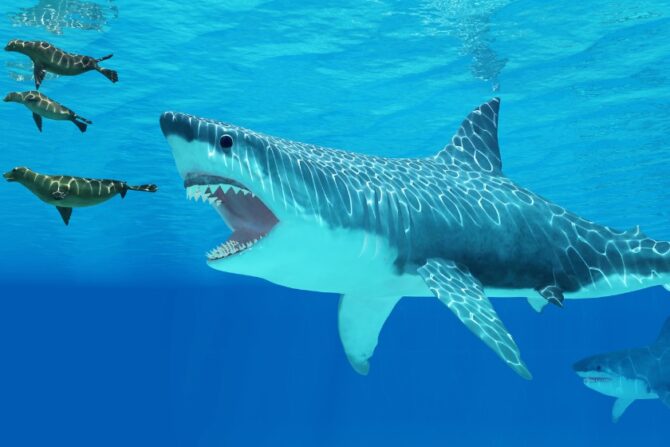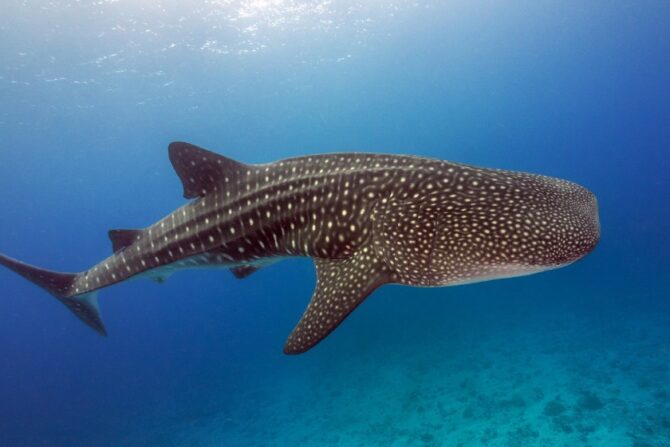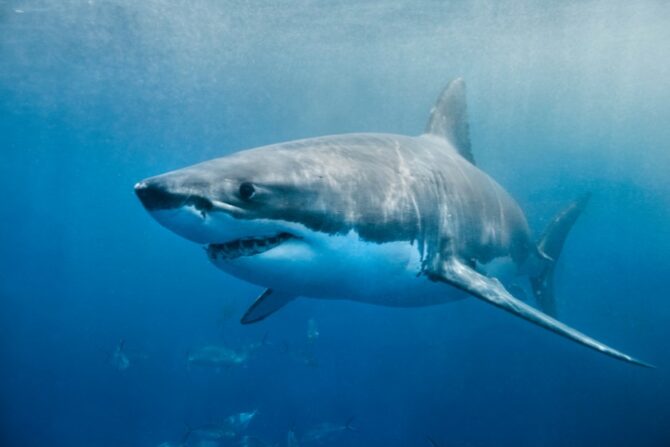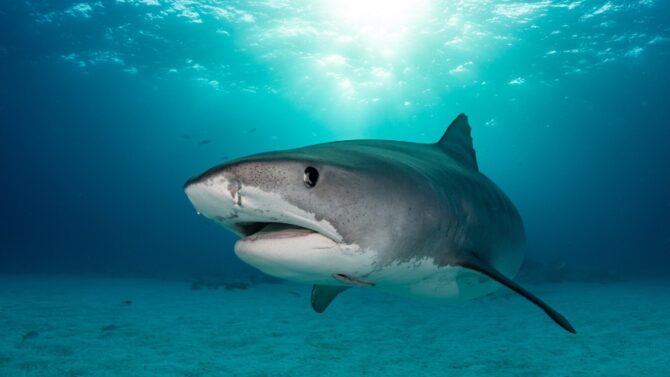The megalodon is a long-extinct species of mackerel shark, but its reputation as one of the ocean’s most dreaded predators still lingers today.
From popular movies like The Meg to internet claims of sightings, this creature won’t be forgotten anytime soon.
While the only fossil available is the megalodon’s tooth, experts have used it to conclude that the megalodon was an enormous creature.
In fact, it is considered the largest shark to have ever lived.
Naturally, this raises the question, “Just how big was the megalodon compared to other species?”
According to research, the megalodon’s size is estimated at around 60 feet in length and over 60 tons in weight.1 This makes it larger than other shark species, including the biggest extant shark today. However, it isn’t the biggest animal to have ever lived.
In this article, we’ll delve into a megalodon size comparison with other large animals.
Megalodon: An Overview

The megalodon was a mackerel shark that existed around 3.6 to 20 million years ago.2
It was once believed to be related to the great white shark and part of the genus Carcharodon.
However, it is now classified under the genus Otodus in the Otondidae family.
The word “megalodon” means “big tooth,” referencing the size of the tooth fossils that have been discovered.
The first discovery happened in 1835, thanks to Louis Agassiz, a Swiss naturalist.
He named the species Carcharodon megalodon until the late 1990s when the shark was placed in the genus Carcharocles.
Since the megalodon is a shark, its skeleton was formed from cartilage rather than bones.
Thus, the only part that could survive through the years is the tooth.
Megalodon Size Comparison: Megalodon Vs. Whale Shark

The whale shark is considered the largest living shark today,3 so it makes sense to compare it with the megalodon before any other species.
How would the megalodon look if it existed alongside the whale shark?
The largest whale shark recorded was exactly 61.7 feet long, although most whale sharks span from 18 to 33 feet in length.
Some are also known to get to 40 feet.
Remarkably, the megalodon’s average length is over 60 feet, which makes it as long as the biggest whale shark.
The megalodon is estimated to have weighed 50 tons, surpassing the whale shark’s average weight of 20 tons.
Conclusion: The megalodon is bigger than the whale shark.
Megalodon Size Comparison: Megalodon Vs. Great White Shark

The great white shark is smaller than the whale shark, which means it’s also smaller than the megalodon.
The average length of the great white shark is between 11 and 16 feet, with the females being bigger.
Notably, some females have grown up to 19 feet.
Regardless of their remarkable length, the megalodon is far longer than them, spanning over 60 feet long.
The great white shark weighs around 0.5 to 1.2 tons, making it heavier than most animals but lighter than the megalodon, which weighs 50 tons.
Despite being smaller, the great white shark is likely to win in a fight against a megalodon.
These sharks are ferocious predators, and while the megalodon is also one, it meets a strong contender in the great white.
Interestingly, the great white shark is even considered a possible cause of the megalodon’s extinction.4
Conclusion: The megalodon is far bigger than the great white shark.
Megalodon Size Comparison: Megalodon Vs. Blue Whale

Now that we know the megalodon is bigger than the great white shark, can we also term it the biggest sea creature ever?
Before we can arrive at an answer, let’s compare the megalodon with the blue whale.
Currently, the blue whale holds the record of being the biggest marine mammal.
It is often said to be the biggest animal to have ever existed, but could that be true when the megalodon enters the equation?
Well, let’s compare the numbers.
Megalodons measure around 60 feet or more in length, but that’s nowhere near the blue whale’s length, which is over 100 feet.
Measuring their weight doesn’t give the megalodon any edge, either.
While the megalodon weighs around 50 tons, the blue whale can weigh up to 180 tons.
So, the difference is clear!
Conclusion: The blue whale is bigger than the megalodon.
Megalodon Size Comparison: Megalodon Vs. Elephant

Elephants are considered the largest living land animals, but how do they fare in size against the megalodon?
Well, let’s find out!
According to World Wildlife Fund, the average length of an elephant is between 19 and 24 feet,5 which is longer than that of many land animals but just around the great white shark’s length.
Of course, this falls short when compared to the megalodon’s 60 feet.
Elephants weigh between 4 and 6 tons, which is heavy by terrestrial animal standards.
However, the megalodon and many other aquatic animals surpass this.
Conclusion: The megalodon is far bigger than the elephant.
Megalodon Size Comparison: Megalodon Vs. Tyrannosaurus

There are many dinosaur species, and a size comparison with each one can’t contain this article.
That’s why we will focus on one of the most popular species, the tyrannosaurus.
These large terrestrial reptiles lived around 66 to 68 million years ago during the Cretaceous period, years before the megalodon came into existence.
The tyrannosaurus measures around 40 feet in length, judging from the complete fossil named Sue.6
While this is close to that of the megalodon, the latter is longer, measuring up to over 60 feet.
The weight difference is also wider.
While the tyrannosaurus weighed from 5 to 7 tons, which pales in comparison to the megalodon’s 50 tons.
Conclusion: The megalodon is bigger than the tyrannosaurus.
Final Thoughts
The megalodon holds the title of the largest shark to have ever existed.
With its enormous size of around 60 feet in length and an estimated weight of 50 tons, it easily outshines today’s sharks, including the whale shark.
It is also larger than the largest terrestrial mammals, like elephants and the extinct tyrannosaurus.
However, as incredible as the megalodon size comparison with these giants is, it falls short compared to the true titan of the ocean—the magnificent blue whale.
Nonetheless, the megalodon’s legacy as the largest predator to have ever existed still stands strong today.
Featured image: The Australian Museum
References & Notes
- Megalodon | Size, Fossil, Teeth, & Facts. Brittanica
- Megalodon: the truth about the largest shark that ever lived. National History Museum
- Whale sharks: Meet the world’s biggest shark. National History Museum
- Did Great White Sharks Drive Megalodon to Extinction? Smithsonian Magazine
- Elephant | Species. World Wildlife Fund
- Sue the T. rex. Field Museum






